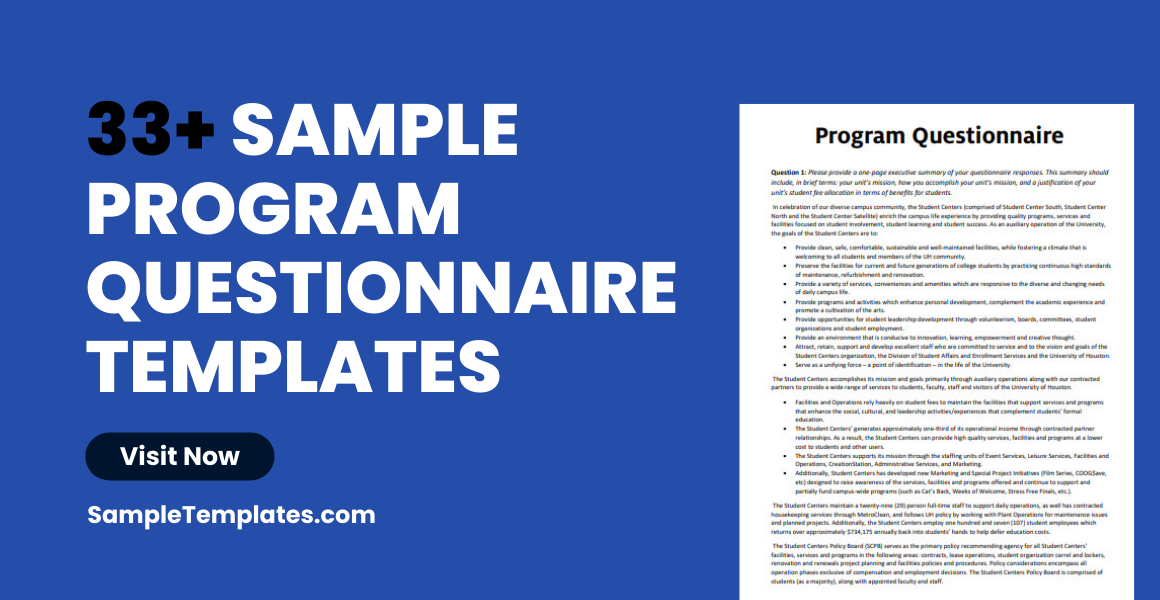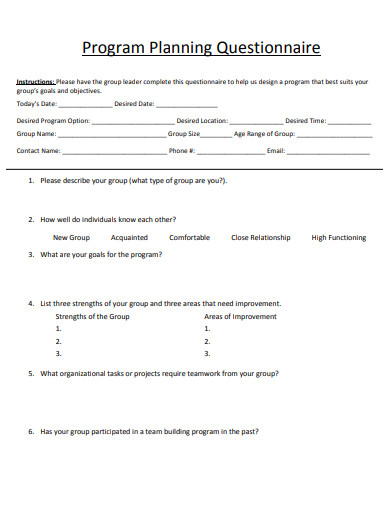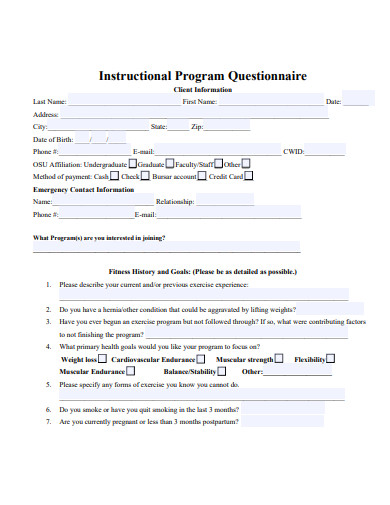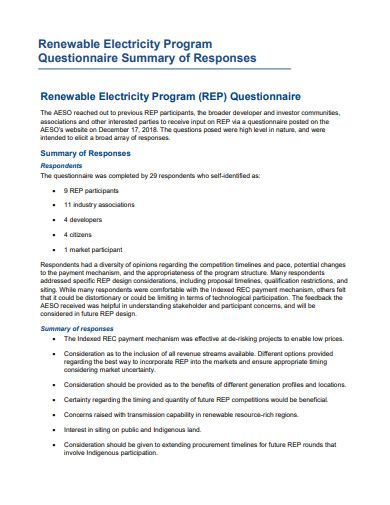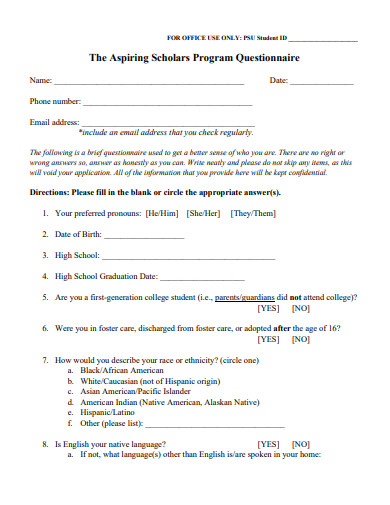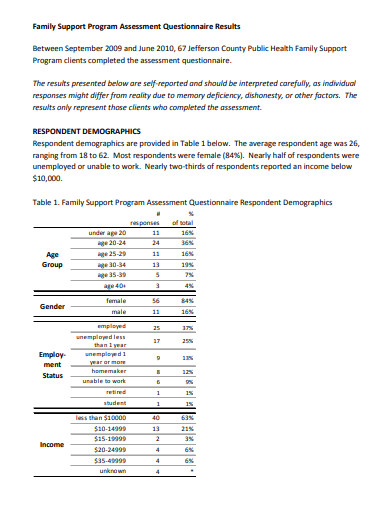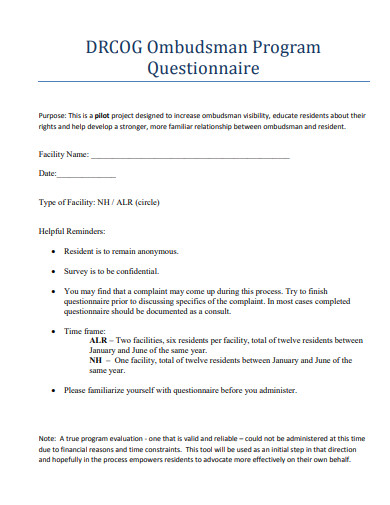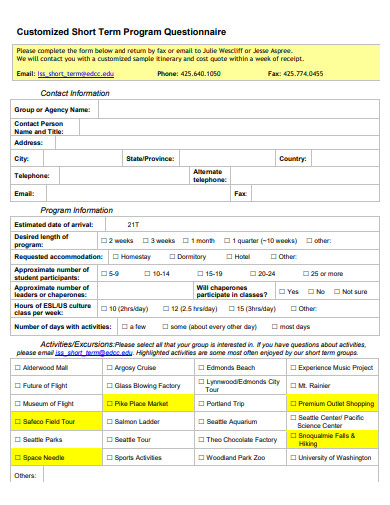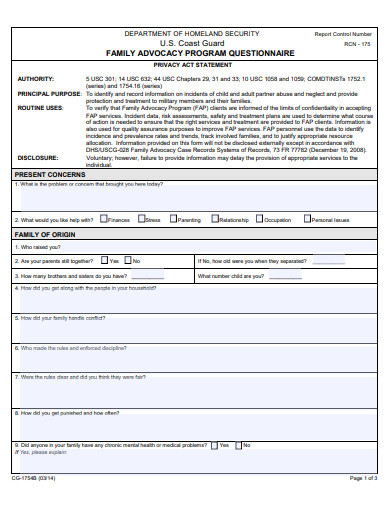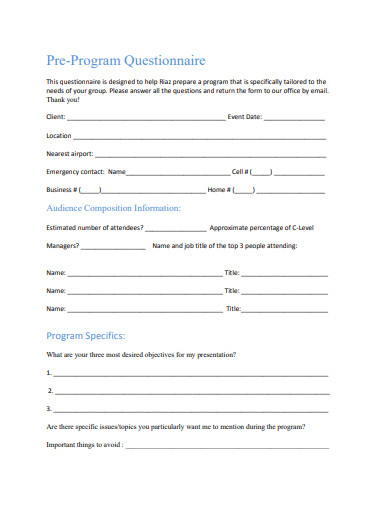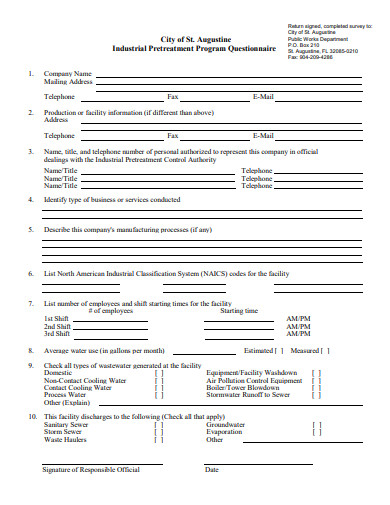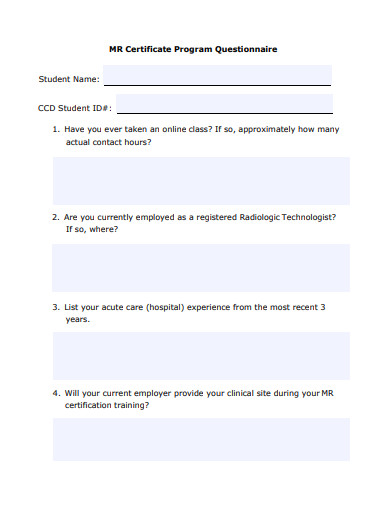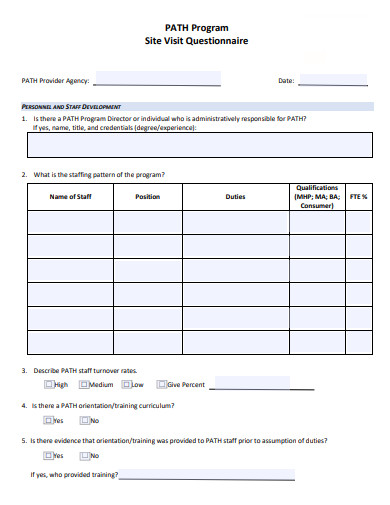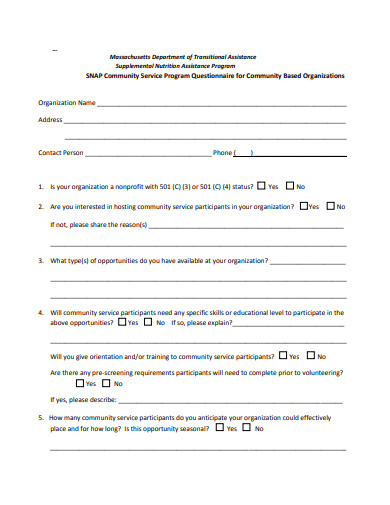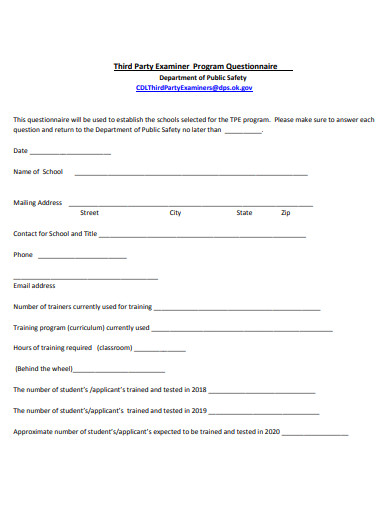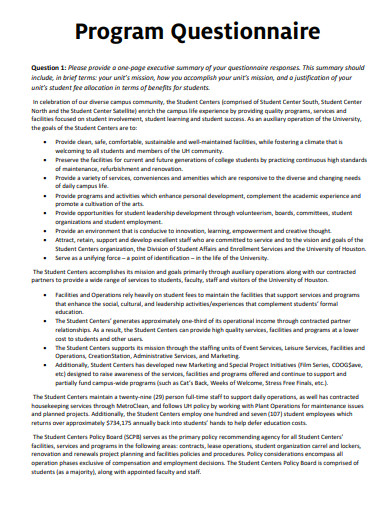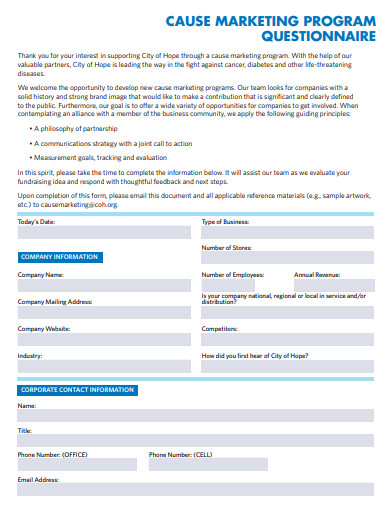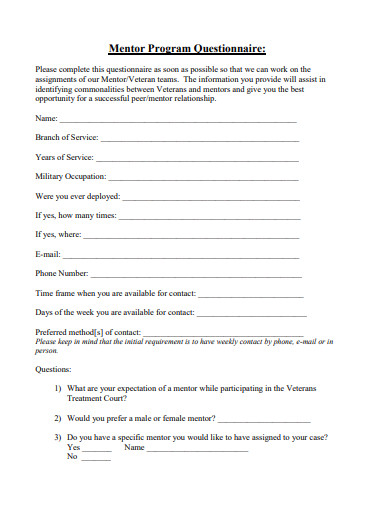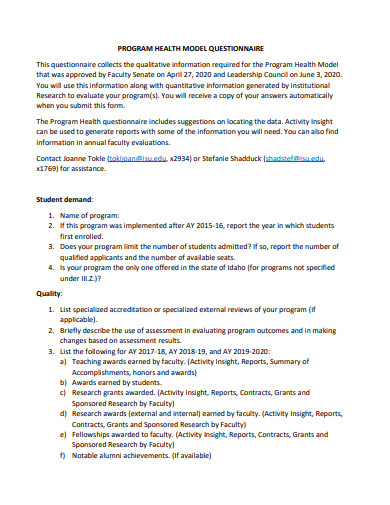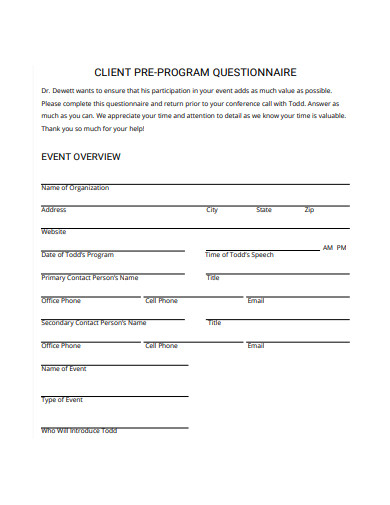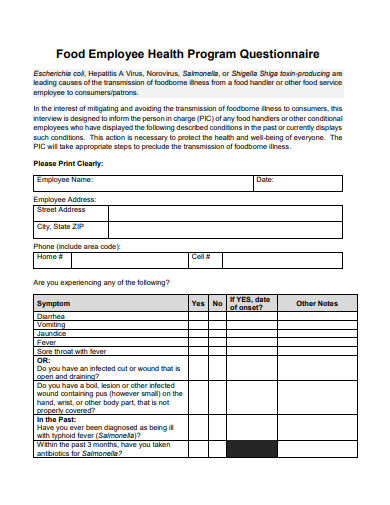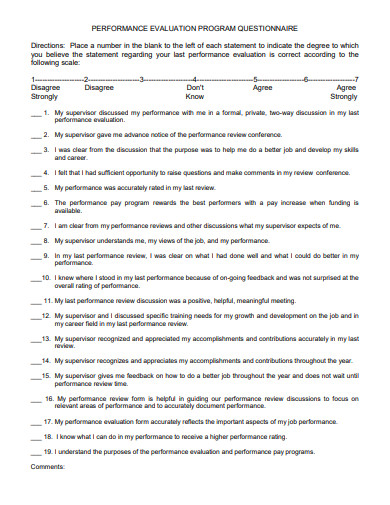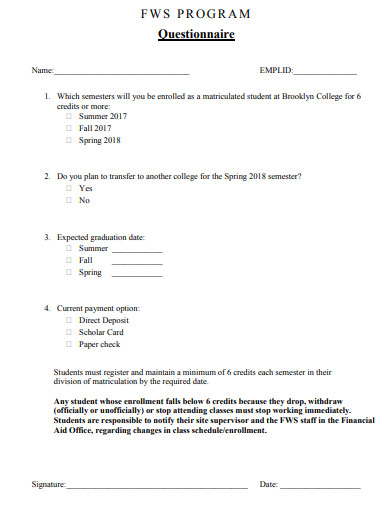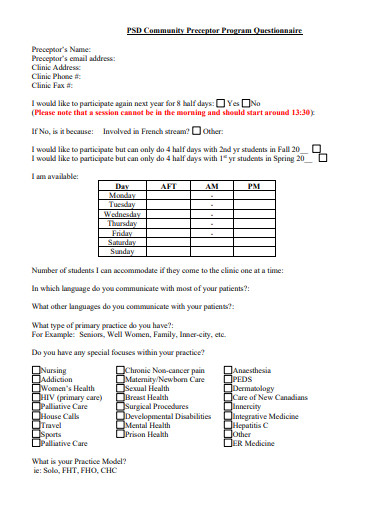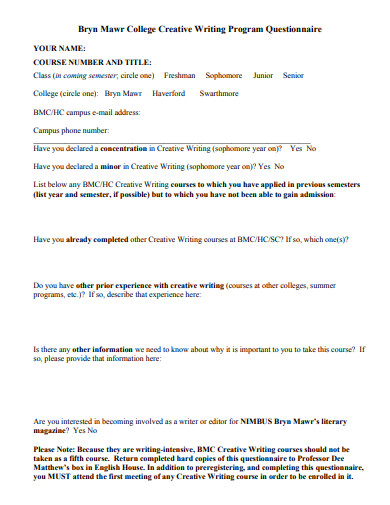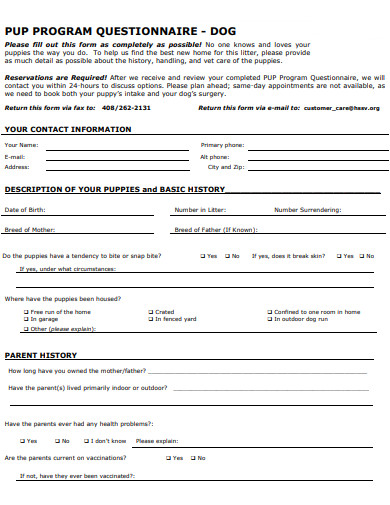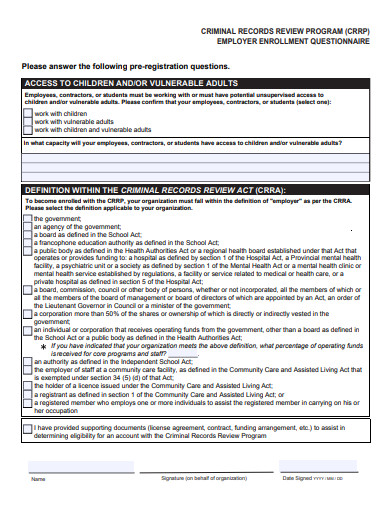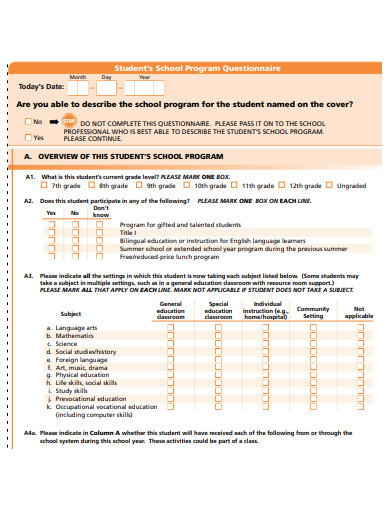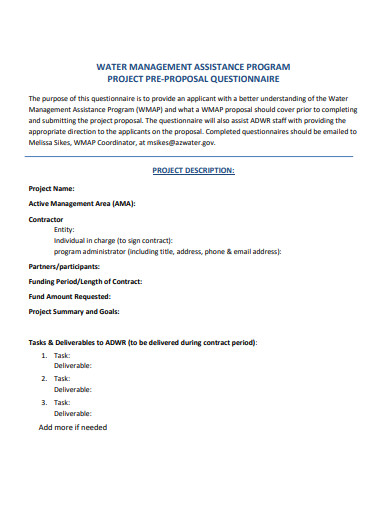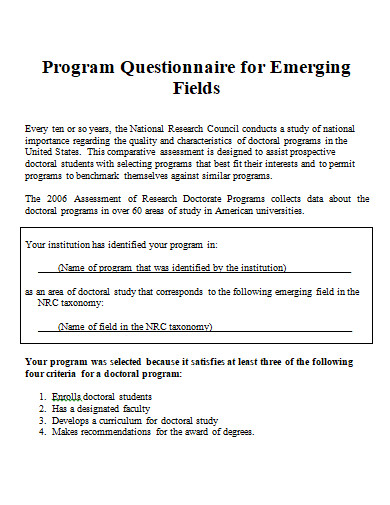Unlock insights with our Sample Program Questionnaire Template! Designed to gather critical feedback, this template aids in refining program offerings to best meet participant needs. Whether you’re launching a new initiative or revamping an existing one, leveraging this sample questionnaire ensures your program resonates with its intended audience. Dive in, and let data-driven decisions guide your program’s success.
33+ Program Questionnaire Samples
1. Program Planning Questionnaire Template
2. Instructional Program Questionnaire Template
3. Renewable Electricity Program Questionnaire Template
4. Scholars Program Questionnaire Template
5. Personnel Reliability Program Questionnaire Template
6. Family Support Program Assessment Questionnaire Template
7. Program Questionnaire Template
8. Customized Short Term Program Questionnaire Template
9. Family Advocacy Program Questionnaire Template
10. Pre-Program Questionnaire Template
What is a program questionnaire?
A program questionnaire is a systematic tool used to collect specific information from participants or stakeholders about a particular sample program or initiative. The primary purpose of this instrument is to gauge the effectiveness, relevance, and impact of a program, whether it’s in the realms of education, business, healthcare, or any other sector.
Key Elements of a Program Questionnaire:
Purpose: Every program questionnaire is developed with a clear intention in mind, whether it’s to assess user satisfaction, determine areas of improvement, or measure the achieved outcomes against set objectives.
Demographics: Often, it’s beneficial to know the background of the respondents to segment feedback. This could include age, profession, educational background, or any other relevant factor.
Questions: These can be open-ended, where respondents provide detailed answers or closed-ended, where they choose from given options. The nature of questions can range from satisfaction levels and user experiences to specific feedback about program content, structure, or delivery methods.
Scale-based Feedback: Many questionnaires include Likert scales or rating systems to measure the degree of agreement or satisfaction among participants.
Importance of a Program Questionnaire:
Feedback Loop: One of the primary uses of a program questionnaire is to establish a feedback loop. By understanding participants’ experiences and opinions, organizations can make informed changes and updates.
Data-Driven Decisions: Instead of relying on assumptions or anecdotal evidence, program questionnaires provide concrete data that can drive decisions about the program’s future direction.
Identify Strengths and Weaknesses: Knowing what’s working and what’s not is crucial. A program questionnaire helps in pinpointing areas of success and aspects that need enhancement.
Engage Stakeholders: By inviting stakeholders to provide feedback, you not only collect valuable data but also make them feel involved and valued. This can lead to increased loyalty and engagement.
Benchmarking: Over time, as you collect data from various iterations of your program, you can benchmark your results, allowing you to measure improvements or declines in specific areas.
Best Practices in Designing a Program Questionnaire:
Clarity: Ensure that every question is clear and straightforward to avoid any misunderstanding.
Brevity: While it’s essential to gather comprehensive data, it’s equally crucial not to overwhelm respondents. Keep it concise.
Relevance: Every question should have a clear purpose. Avoid adding questions that don’t directly relate to your program’s objectives.
Anonymous Responses: To get genuine and candid feedback, ensure respondents that their answers will remain confidential.
Pilot Test: Before rolling out your questionnaire to a larger group, test it with a smaller audience to identify any unclear or misleading questions.
A program questionnaire is a potent tool in the arsenal of any program manager or organizer. It offers a structured method to collect feedback, analyze results, and implement changes, ensuring that a program remains relevant, effective, and in line with its objectives. When executed well, it not only elevates the program’s quality but also strengthens the bond between the organizers and the participants, leading to sustained
11. Industrial Pretreatment Program Questionnaire Template
12. Certificate Program Questionnaire Template
13. Program Site Visit Questionnaire Template
14. Community Service Program Questionnaire Template
15. Third Party Examiner Program Questionnaire Template
16. Program Questionnaire in PDF
17. Partner Program Application Questionnaire Template
18. Marketing Program Questionnaire Template
19. Radiologic Technology Program Questionnaire Template
20. Mentor Program Questionnaire Template
21. Program Health Model Questionnaire Template
How to Create a Program Questionnaire
Creating a program questionnaire is an art and science of strategically gathering feedback to enhance a program’s effectiveness. A well-constructed questionnaire provides actionable insights, helping decision-makers optimize programs to better serve their intended audience. Here’s a guide to creating a compelling program questionnaire:
Define Your Objectives:
Before you start drafting questions, be clear about what you want to achieve. Are you looking to assess overall satisfaction, gather feedback on specific aspects, or determine areas of improvement? Your objectives will guide the types of questions you include.
Choose the Right Question Types:
There are various question types, and your choice should align with your objectives.
Multiple Choice: Suitable for gathering categorical data or when you want to provide specific response options.
Open-Ended: Useful when seeking detailed, qualitative feedback.
Scale/Rating: Ideal for gauging satisfaction levels or degrees of agreement.
Start with Demographic Questions:
Demographic questions help segment feedback. Understand who is providing feedback, whether based on age, profession, or any other criteria relevant to your program.
Craft Clear and Unbiased Questions:
Avoid leading questions that might influence a respondent’s answer. Ensure that each question is straightforward, avoiding jargon or ambiguous terms.
Keep It Concise:
While it’s tempting to gather as much data as possible, a long questionnaire can lead to survey fatigue, resulting in drop-offs or rushed answers. Aim for a balance between comprehensiveness and brevity.
Use Logical Flow:
Arrange your questions logically. Start with general questions, progressively diving into specifics. This flow makes the process smoother for respondents.
Include an Open Feedback Section:
Allow space for participants to provide additional comments or insights that might not fit within your structured questions. This often uncovers valuable and unexpected insights.
Pilot the Questionnaire:
Before full-scale distribution, test your questionnaire with a small group. Their feedback can help refine questions, remove ambiguities, or identify missing areas.
Ensure Anonymity and Confidentiality:
To get honest feedback, reassure participants that their responses are confidential. If the survey is anonymous, state it explicitly.
Choose an Appropriate Platform:
There are several online platforms, like SurveyMonkey, Google Forms, or Typeform, that offer user-friendly interfaces for creating and distributing questionnaires. Choose one that aligns with your needs and audience.
Analyze and Act on Feedback:
Once you’ve gathered responses, analyze the data methodically. Look for patterns, areas of concern, or particularly successful aspects. Then, incorporate this feedback into actionable changes or improvements.
Share Findings (if appropriate):
Consider sharing key findings or actions taken based on feedback with the respondents or broader audience. This demonstrates that you value their input and fosters trust and engagement.
Creating a program questionnaire is a continuous learning process. It’s not just about asking questions but about asking the right questions in the right way. By following these guidelines and being open to refining your approach based on experience, you can gather valuable insights that drive program excellence. Remember, feedback is a gift, and a well-constructed questionnaire is a bridge to that invaluable treasure.
22. Program Applicant Questionnaire Template
23. Client Pre-Program Questionnaire Template
24. Food Employee Health Program Questionnaire Template
25. Performance Evaluation Program Questionnaire Template
26. Basic Program Questionnaire Template
27. Community Preceptor Program Questionnaire Template
28. College Creative Writing Program Questionnaire Template
29. Program Questionnaire Example
30. Printable Program Questionnaire Template
31. Students School Program Questionnaire Template
32. Program Project Pre-Proposal Questionnaire Template
33. Visa Direct Program Implementation Questionnaire Template
34. Program Questionnaire in DOC
The Six Types of Questionnaires
Questionnaires are essential tools in research, marketing, education, health care, and various other fields. They enable the systematic collection of data from respondents for specific purposes. The format and design of a questionnaire can vary greatly depending on its purpose and the nature of the data being collected. Here are six primary types of questionnaires:
Structured Questionnaires:
Structured questionnaires consist of a fixed set of questions presented in a predetermined order. All respondents receive the exact same questions, ensuring uniformity in the data collection process. This type is especially popular in quantitative research, where data is typically analyzed statistically.
Advantages: Ease of data analysis, consistency across respondents.
Disadvantages: Less flexibility, may not capture nuanced or unexpected responses.
Unstructured Questionnaires:
Opposite to structured ones, unstructured questionnaires are more open-ended. They may provide a general direction or topic, but respondents are free to share their views without being constrained by specific answer choices.
Advantages: Can capture rich, qualitative data and uncover new insights.
Disadvantages: More challenging to analyze due to varied responses.
Closed-ended Questionnaires:
In closed-ended questionnaires, respondents select their answers from a provided list of options. This might include yes/no questions, multiple-choice questions, or Likert scale questions.
Advantages: Straightforward to administer and analyze, especially with a larger sample size.
Disadvantages: Limited response options, potential for missing out on nuanced feedback.
Open-ended Questionnaires:
This type features questions that require respondents to provide more detailed answers in their own words. They are especially useful when seeking to understand feelings, opinions, or experiences in depth.
Advantages: Detailed insights, flexibility in responses.
Disadvantages: Time-consuming to analyze, potential for varied interpretation.
Mixed Questionnaires:
As the name suggests, mixed questionnaires combine elements of both closed and open-ended question formats. This allows researchers to gather quantitative data while also leaving room for qualitative insights.
Advantages: Versatility, capability to capture both statistical and nuanced data.
Disadvantages: Longer to complete, requires more comprehensive data analysis.
Pictorial Questionnaires:
Particularly useful when working with diverse populations, children, or individuals with literacy challenges, these questionnaires use images to represent questions or answer choices. Respondents can select or sequence pictures to provide their responses.
Advantages: Inclusive, especially useful for populations with language or literacy barriers.
Disadvantages: Limited in the complexity of information they can capture.
The type of questionnaire chosen often depends on the goals of the survey, the target audience, and the nature of the data desired. It’s essential to be clear about the research objectives and the kind of insights needed before settling on a particular type. Each type has its advantages and drawbacks, so understanding these can guide researchers or professionals in crafting effective, impactful questionnaires. By choosing the right format and carefully designing questions, one can maximize the value and accuracy of the data collected.
Related Posts
Sample Business Card Templates
Sample Cashier Job Descriptions
Questionnaire Samples
FREE 10+ Sample HR Resource Templates in PDF
FREE 10+ HR Consulting Business Plan Samples in MS Word | Google Docs | Pages | PDF
FREE 49+ Sample Job Descriptions in PDF | MS Word
FREE 16+ Nonprofit Budget Samples in PDF | MS Word | Excel | Google Docs | Google Sheets | Numbers | Pages
FREE 13+ Academic Calendar Templates in Google Docs | MS Word | Pages | PDF
FREE 10+ How to Create an Executive Summary Samples in Google Docs | MS Word | Pages | PDF
FREE 23+ Sample Event Calendar Templates in PDF | MS Word | Google Docs | Apple Pages
Company Profile Samples
FREE 10+ Leadership Report Samples [ Development, Training, Camp ]
FREE 24+ Sample Payment Schedules in PDF | MS Word
FREE 10+ Return to Work Action Plan Samples in PDF | DOC
Autobiography Samples & Templates
